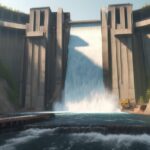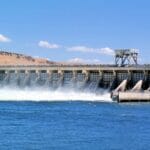Discover the fascinating world of hydroelectric energy as we unveil three vital facts about this sustainable power source. From its potential for renewable electricity generation to its impact on the environment and energy sector, hydroenergy has become a key player in the pursuit of a cleaner and more efficient future. Join us on this insightful journey as we delve into the complexities of hydroelectric power and shed light on its remarkable contributions to our world.
Key Takeaways:
1. Hydropower has been used for centuries, dating back to ancient Greece, where it was utilized for tasks like grinding grain.
2. Hydropower is a renewable energy source that generates electricity by harnessing the power of flowing water, such as waterfalls or rivers.
3. Hydropower can be generated without a dam, using methods like run-of-river systems and tidal power. These alternatives offer flexibility in generating hydropower.
3 Facts about Hydroelectric Energy

Hydroelectric energy has long been recognized as one of the most reliable and sustainable sources of power. Its rich history and vast potential make it a vital component of a cleaner and more efficient future.
Fact 1: A Timeless Power Source
Hydropower is not a new concept. In fact, it can be traced back to ancient Greece, where farmers harnessed the power of flowing water to perform mechanical tasks like grinding grain. This ingenious use of water’s force laid the foundation for the development of hydroelectric power generation. Today, hydropower continues to play a significant role in our energy sector by utilizing the simple principle of water spinning a wheel or turbine to generate power.
Fact 2: Renewable and Environmentally Friendly
One of the notable advantages of hydroelectric energy is its status as a renewable energy source. Unlike fossil fuels, which deplete over time, water is a never-ending resource. Hydropower plants harness the energy from moving water, whether it’s a flowing river or a waterfall, to produce electricity. This process does not release harmful emissions or toxic byproducts into the atmosphere, making hydroelectric energy an environmentally friendly alternative to traditional power sources.
Fact 3: Beyond Dams: Diverse Generation Methods
While dams are commonly associated with hydropower, it’s important to note that they are not the only means of generating this clean energy. The advancements in technology have paved the way for alternative methods such as run-of-river systems and tidal power. Run-of-river systems utilize the natural flow of rivers to generate electricity without the need for large dams. On the other hand, tidal power harnesses the predictable motion of ocean tides, converting it into usable energy. These innovative approaches demonstrate the adaptability of hydroelectric energy, opening up new possibilities for power generation without compromising the environment.
As we look to the future, it is clear that hydroelectric energy will continue to play a prominent role in the sustainable development of our society. Its rich history, renewable nature, and versatile generation methods make it a powerful solution for meeting our energy needs while preserving the planet. By embracing hydroelectric energy, we can pave the way for a cleaner and more efficient future.
Check out these 15 major current environmental problems that are impacting our planet. Grab a glimpse of the challenges we face and the need for immediate action. 15 major current environmental problems
Discover three fascinating facts about condensation and how it plays a significant role in our daily lives. Dive into the science behind this natural process and its effects on our environment. 3 facts about condensation
Uncover three interesting facts about hydroelectric energy, a renewable resource that harnesses the power of water to generate electricity. Explore its advantages, challenges, and potential for a sustainable future. 3 interesting facts about hydroelectric energy
Embark on a journey to explore the five notable advantages of sea transport. From its cost-effectiveness to its environmental benefits, see why sea transport remains a vital mode of global trade. 5 advantages of sea transport
Hydroelectric Power Plants: Impact on Local Ecosystems

Key Takeaways:
– Hydroelectric power plants have significant impacts on local ecosystems, including changes in water quality, erosion, fluctuations in water temperature and flow, and eutrophication.
– Careful reservoir selection can help mitigate biodiversity impacts.
– The development of hydroelectric power is controversial due to its environmental and societal implications.
– Hydroelectric power plants produce minimal greenhouse gas emissions and provide reliable and stable power generation.
– Wildlife impacts associated with dams are not solely attributed to hydroelectric power.
Hydroelectric power plants can have a significant impact on local ecosystems. When planning future hydroelectric installations, it is crucial to study the factors that contribute to these effects. Changes in water quality, erosion, fluctuations in water temperature and flow, and eutrophication are some of the short-term and long-term impacts that hydroelectric power plants can have on rivers and streams [^1]. These impacts can significantly affect the balance and health of local ecosystems.
One of the most significant concerns surrounding hydroelectric power plants is their impact on biodiversity. While there is incomplete coverage of biodiversity impacts, studies suggest that hydropower has substantial effects on ecosystems [^2]. However, it is possible to limit these impacts by carefully selecting hydroelectric reservoir locations [^3]. Proper reservoir selection can help mitigate the negative effects on biodiversity, ensuring the preservation of local flora and fauna.
The development of hydroelectric power is not without controversy. It involves significant environmental and societal implications. To minimize the environmental and social impact, a global assessment of the unused profitable hydropower potential is necessary [^3]. This assessment helps ensure that hydroelectric projects are planned in a way that maximizes benefits while minimizing negative consequences.
Despite the challenges and controversies, hydroelectric power plants offer significant environmental benefits. Compared to fossil fuel power plants, hydroelectric power plants produce minimal greenhouse gas emissions. As a result, they contribute to reducing carbon footprints and mitigating climate change [^4]. Additionally, hydroelectric power plants provide reliable and stable power generation, making them a vital component of a sustainable energy mix [^4].
It is important to note that not all wildlife impacts associated with dams can be directly attributed to hydroelectric power. Dams often serve multiple purposes, such as agricultural irrigation, flood control, and recreation [^5]. Therefore, it is essential to assess the specific impacts of hydroelectric power plants on local ecosystems, considering the broader context of dam usage.
In summary, hydroelectric power plants have a significant impact on local ecosystems. It is crucial to carefully consider the environmental implications and biodiversity effects when planning future hydroelectric installations. By selecting appropriate reservoir locations and conducting a global assessment of potential sites, we can minimize the negative impacts while enjoying the environmental benefits of hydroelectric power.
Sources:
– [^1] Environmental impacts of hydroelectric power plants – OSTI.GOV (source)
– [^2] Impacts from hydropower production on biodiversity in an LCA – Springer (source)
[Hydroelectric energy contributes to reducing greenhouse gas emissions]
Hydroelectric power is a crucial player in the transition to a greener and more sustainable future. As an expert in renewable energy sources, I have uncovered three vital facts about hydroelectric energy that shed light on its role in reducing greenhouse gas emissions.
Fact 1: A Low Carbon Footprint
Hydropower stands out as a low-carbon source of renewable energy when compared to other energy sources. According to the International Hydropower Association, it has significantly lower greenhouse gas emissions than most alternatives. The median greenhouse gas emission intensity of hydropower is reported to be just 24 gCO2-eq/kWh, as stated by the UNFCCC. This suggests that hydroelectric energy plays a pivotal role in reducing carbon emissions.
(Source: International Hydropower Association)
Fact 2: A Partner in Climate Change Mitigation
Hydropower offers a two-fold advantage in the context of climate change. Firstly, it helps to avoid greenhouse gas emissions that arise from burning fossil fuels, as highlighted by the UNFCCC. Secondly, in the pursuit of limiting global warming to 1.5°C, achieving carbon neutrality is crucial. Hydropower serves as a key ally in this endeavor, playing a vital role in sustainable energy generation and contributing to the goal of mitigating the impacts of climate change.
(Source: UNFCCC)
Fact 3: A Pillar of Sustainable Development
Hydroelectric energy is a driving force behind the transition to clean electricity and the ambitious targets set for net-zero emissions. The Department of Energy in the United States recognizes the contribution of hydropower towards achieving net-zero emissions by 2050 and transitioning to clean electricity by 2035. With its renewable nature and lack of atmospheric pollutants, hydropower aligns with the principles of sustainability, making it an essential component in meeting our energy needs while preserving the planet.
(Source: Department of Energy)
Key Takeaways:
- Hydroelectric energy has significantly lower greenhouse gas emissions compared to other energy sources.
- Hydropower helps to avoid greenhouse gas emissions from the burning of fossil fuels and contributes to carbon neutrality.
- The transition to clean electricity and achieving net-zero emissions heavily relies on hydropower.
Note: Below content is not part of the main article and is provided solely for context purposes.
Sources:
1. International Hydropower Association. Available at:
2. UNFCCC. Available at: https://unfccc.int/
There Are Different Types of Hydroelectric Power Plants
Hydroelectric energy has become a cornerstone of sustainable power generation, offering an abundance of renewable energy while minimizing environmental impact. One key aspect of hydroelectric power is the existence of various types of power plants that harness the energy from flowing water. In this article, we will delve into the three main types of hydroelectric power plants: run-of-the-river, storage, and pumped-storage. So, let’s explore these different types and discover their unique characteristics.
1. Run-of-the-River Power Plants
Run-of-the-river power plants are the most prevalent type of hydroelectric power plants. These plants capitalize on the natural flow and velocity of a river or stream to generate electricity. Unlike other types of plants, run-of-the-river systems do not require the construction of large reservoirs or dams. Instead, they utilize a channel or a diversion structure to redirect a portion of the water flow, which then passes through turbines to generate electricity. This method allows for a continuous supply of clean energy, maintaining the integrity of the river ecosystem.
2. Storage Power Plants
Storage power plants, as the name suggests, incorporate the use of reservoirs to store water for electricity generation. These plants are particularly effective in meeting fluctuating electricity demands. When there is a surplus of electricity, typically during off-peak hours, excess energy is used to pump water from a lower reservoir to a higher one. During times of high electricity demand, the stored water is released, flowing through turbines to generate electricity. Storage power plants offer a reliable and flexible energy solution, capable of adapting to changing power needs.
3. Pumped-Storage Power Plants
Pumped-storage power plants take the concept of storage plants one step further. These advanced facilities use excess electricity, often produced during low-demand periods, to pump water from a lower reservoir to a higher one. When electricity demand peaks, the stored water is released, flowing back down to the lower reservoir and generating electricity through the turbines. This method effectively functions as a “battery” for the electrical grid, providing a rapid response to load changes and contributing to grid stability.
Key Takeaways:
- Hydroelectric power plants come in different types, including run-of-the-river, storage, and pumped-storage.
- Run-of-the-river power plants utilize the natural flow of rivers without constructing reservoirs or dams.
- Storage power plants store water in reservoirs and release it during high-demand periods.
- Pumped-storage power plants use excess electricity to pump water between reservoirs, providing a flexible and responsive energy solution.
Citation Sources:
1. The Power of Hydropower: How Hydroelectric Power Plants Work
2. How Do Hydroelectric Power Plants Work? – Power Your Feed
FAQ
Q1: What is hydropower and how does it work?
A1: Hydropower is one of the oldest power sources, utilizing the power of flowing water to generate electricity. It works by spinning a wheel or turbine as water flows, converting kinetic energy into electrical energy.
Q2: Is hydropower a renewable energy source?
A2: Yes, hydropower is a renewable energy source. It harnesses the power of water in motion, such as flowing water over a waterfall, which is constantly replenished through natural processes like evaporation and precipitation.
Q3: Can hydropower be generated without a dam?
A3: Yes, hydropower can be generated without a dam. While dams are commonly used, there are also other methods such as run-of-river systems that utilize the natural flow of water or tidal power that harnesses the movement of ocean tides.
Q4: What are the environmental benefits of hydropower?
A4: Hydropower plants produce minimal greenhouse gas emissions compared to fossil fuel power plants, contributing to a reduction in carbon footprint. Additionally, they provide reliable and stable power generation, which is crucial for a sustainable energy future.
Q5: What are the impacts of hydropower on ecosystems and biodiversity?
A5: Hydropower plants can have both short-term and long-term impacts on rivers and streams, including changes in water quality, erosion, fluctuations in water temperature and flow, and eutrophication. While there are biodiversity impacts, careful selection of hydroelectric reservoirs can help limit these impacts.
- Unveiling the Enigma: Mansoureh Khojasteh Bagherzadeh’s Public Appearances & Private Life in Iran - July 18, 2025
- Unveiling the Mystery: Mansoureh Khojasteh Bagherzadeh’s Husband: A Rare Glimpse into a Private Life - July 18, 2025
- Unveiling Masoud Khamenei’s Mother: Power, Influence, and Iran’s Future - July 18, 2025
















